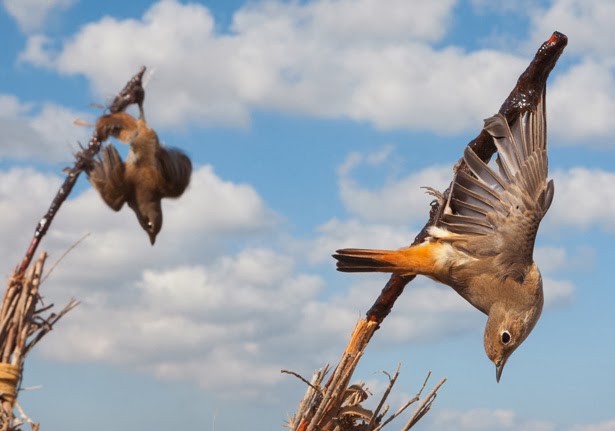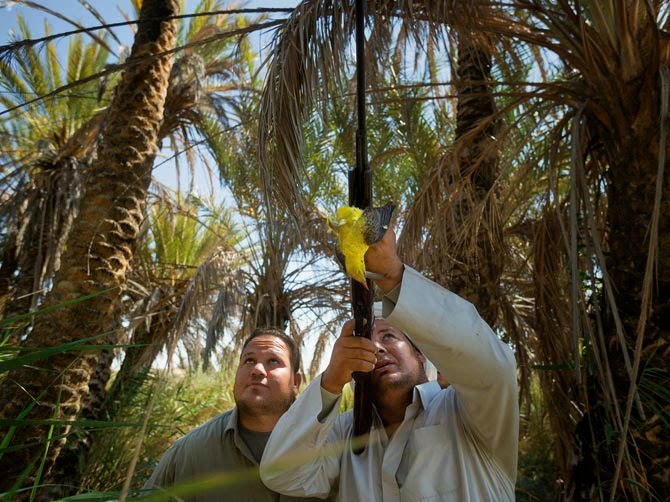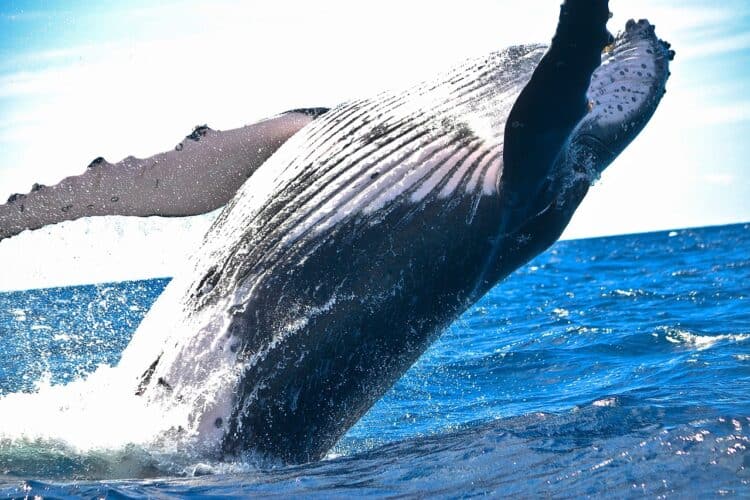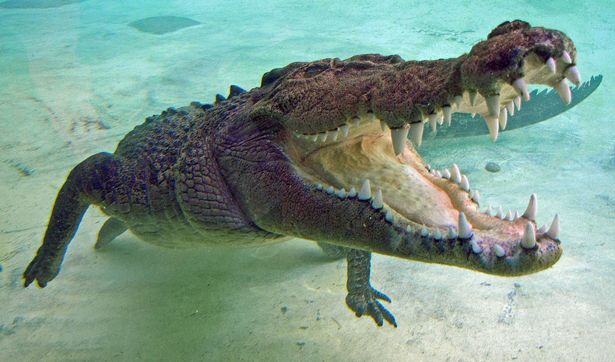Each year, millions of songbirds are killed for food, for profit or just for the joy of shooting something, as they move from their winter grounds in Africa to their summer breeding territories in Europe.
In Egypt, hundreds of miles of nets cover the entire coastline, catching almost every bird that makes its way to shore from across the Mediterranean Sea. In Albania, hunters set up dozens of hunting blinds inside wildlife refuges while officials turn a blind eye.
In Cyprus, trees are outfitted with glue-covered lime sticks that catch birds like flies on flypaper as they attempt to land, breaking wings as the birds struggle to free themselves. The problem is widespread and growing as new methods and technology increase the deadly toll of the annual slaughter.
Reliable numbers don’t exist for the overall count of birds taken by poachers each year. Novelist Jonathan Franzen, on assignment for National Geographic, witnessed the migration throughout southern Europe and Egypt and estimated that a single Egyptian farmer might catch and kill more than 5,500 birds during a 30-day period in the height of migration. That number would include hundreds of golden orioles, similar numbers of hoopoes and turtledoves and many dozens of different species of smaller birds.
Franzen estimates that mist nets — nets made of line so thin as to be almost invisible to birds — catch as many 100,000 quail from a total breeding population estimated at two to three million pairs (and falling sharply year after year). Though the methods differ from region to region, the indiscriminate hunting of migratory songbirds is prevalent throughout Europe and the Middle East and results in the loss of millions of birds annually from nearly every species that migrates through the area. Franzen cites examples from France, Spain, Italy, Albania, Cyprus and Egypt.
The July issue of National Geographic covers the slaughter in detail with photos taken by David Guttenfelder, the chief Asia photographer for the Associated Press. I spoke with Guttenfelder, an experienced conflict photographer, about what he witnessed and the emotional impact it had on him. Below are portions of our talk.












Q: In some cases, this sort of bird hunting is a very old cultural practice. How to you respond to someone who might say, we’ve been doing this for 500 years and the birds still come?
A: Most of them said, we’ve been doing this for generations and the birds aren’t coming like they used to. The Egyptians have mist nets along the Mediterranean coast line. Five hundred miles of continuous nets without a break catching every quail that comes in. The populations of quail are just nose-diving in Europe and they would say, you know, we’re not getting anywhere near the number of quail that we used to. I wonder why. Maybe it has to do with more city lights, or development, maybe they are hunting more in Europe.
It has to do with a lot of things, but I didn’t hear anyone take responsibility and say I wonder if it has to do with the fact that I, personally, took nearly a thousand quail on my 300-foot stretch of net this season. They’ve been doing it for a very long time. They always saw it, in a place like Cyprus or Egypt, as a free source of protein twice a year, which just came out of the skies. No one, probably, could ever imagine that this would ever end, that they would ever lose this, but it is not sustainable.
There are two different aspects of bird hunting covered in the article. It mentioned that Bedouins typically eat what they catch for example, while in Albania a group of people with Kalishnikovs looted from government arsenals during the war mowed down an entire flock of 50,000 migrating geese to sell them for profit. Can you talk about the differences in the attitudes toward bird hunting in the areas you visited?
Everywhere we went there was a lack of understanding of the impact, a lack of understanding of what is sustainable. There were places were it just didn’t matter that much to people. In Cyprus, for example, people know. To be part of the European Union, they had to make songbird hunting illegal, and they do it anyway. They fight and say, this is our culture, knowing very well that it is not sustainable. It’s indiscriminate; you can’t kill a plentiful type of songbird and not kill highly endangered songbirds because lime sticks and mist nets kill everything.
People were doing it Albania and Cyprus just blatantly breaking their own laws, attacking activists who were coming and trying to get Cypriots to abide by their own laws, attacking them and hospitalizing activists. There were people in Egypt, I’m sure, who just never had it occur to them the impact they had. They were quite proudly walking down the road with a stringer of 50 golden orioles the way a farm boy in Iowa would walk down the road with a stringer of fish, proudly displaying their catch. At the other extreme, people were putting up walls around their houses to hide their nets because they knew what they were doing was illegal and wrong.
In places like the United States, for example, environmentalists have forged alliances with hunters, in which both realize that it is important to preserve habitats and set limits to ensure future generations of animals. Do you see something like that developing in these other regions?
In France and Italy, people have made a difference. There are laws and regulations about hunting in the United States, and there are supposed to be in a lot of the places we traveled. In Albania, for example, there is protected land. The whole coast is protected, especially in March when we were there, during the spring migration.
The national parks were just magnificent and should be the best refuge for birds in all of that part of Europe, but there is nothing there. The whole environment has been disturbed. All hunting is off-limits there, and we saw dozens and dozens of hunting blinds and hunters with guns going off everywhere. Even when we traveled with the Deputy Minister of the Environment, who has a PhD in ornithology, there were gun blasts going off. There are laws against songbird poaching, yet practically every family on that part of the island had lime sticks in their trees. Some were doing it on an industrial scale. Families had walled compounds and nets, huge nets, doing it for major profit.
What do you see as the root causes of this complete disregard for the rules?
There is huge profit to be made. A songbird on a plate can bring 10 dollars. They are selling them by truckloads. I think money is the biggest reason. They’ll say it’s cultural, we can do what we want, but then we have activists coming, Cypriot activists as well as activists from the rest of the European Union, to try to make Cypriots follow their own laws, and those people would say, no, it’s not a matter of culture. These are not your birds. They are migratory birds. They are everyone’s birds. They are just passing through. We have to take responsibility in the entire region to make sure we can protect them enough that these birds will still be around.
Typically if people break the law, there are penalties. That’s not the case there?
There are no laws against it in Egypt and some of the places we traveled. There are laws and protected areas in Albania, but there is enough corruption and enough wild popularity of hunting that nothing is being enforced. In Cyprus, the same. It’s a total disregard for the law. In Italy, there is a lot being done. You have to give them credit, the Italians have an entire group, like special forces out there in the mountains working so hard trying to do something, but they are fighting against a very long cultural tradition and people who think, “I’m only taking a few birds, I’m not the problem.” Yet, the sum of all the people who are active poachers is doing real damage. I think it’s fair to say that across Europe the majority of people lean toward conservation, but there’s the minority of people who want to hunt without regulations and against the law who can do enough damage that it’s significant.
Hunting isn’t the only thing. There is a long list of reasons why birds are already in trouble. They are trying to make this incredibly difficult migration and they are getting ambushed in every single place they land. They stop in Cyprus and every single tree has gluey lime sticks in it. They go to Egypt and the entire coast has hundreds of miles of nets. If they cross that and make it across the desert, they land in an oasis the size of a high school football field and there are five hunters under every tree has a net draped over it. There is nowhere else to go.
Each person doesn’t think their hunting practices are making any difference, but in the aggregate, because there are so many of them, they do make a difference. On the other hand, the opposite may be true for the activists who try to make a difference, but who are so few.
They are very few. They admit that they are not going to change anything by hopping fences and saving one bird at a time, because it is just so widespread. They are trying to make a difference by working with local authorities and trying to change people’s attitudes. They are trying to get the authorities to enforce their own laws, but I think most of them know that saving one bird from a tree doesn’t help, but they are very serious bird lovers. Some of them are animal rights activists. Some are serious ornithologists.
There was a police officer from England whose father was an Iraq War veteran who taught him to love birds, so he volunteers his time. He didn’t have any illusion that he was going to change the world, but to find one bird, for these people, this tiny thing, to pull it down carefully, to clean it. They were cleaning it with their mouths, putting the wings and feet in their mouths and sucking the glue off the bird before setting it free. For someone who loves birds, to save one bird’s life is really important.
You said that before this assignment, you were not particularly interested in bird watching. Has that changed?
I wasn’t a bird watcher. Most of us go to the supermarket and birds fly through the parking lot. We don’t even see them or hear them, really. One of the things I’ve always loved about working in news is that I work with incredibly passionate people — other journalists, aid workers, combatants, people for whom it’s everything in their life. It’s so intense. I met people like that out there, for whom birds are their life. You think a brown bird with some drab coloring is not interesting until you see it up close and see how beautiful it is. When you understand how difficult their migration is, it’s unbelievable. It’s like a miracle that they can survive this thing even without hunters. Yes, I was really moved by birds.
A story about birds isn’t typical for you as the chief photographer for the Associated Press in Asia with a history of conflict photography. What stories had you covered prior to this?
Before this story for National Geographic, I did one about opium wars in Afghanistan, and I did one about the inside of the nuclear exclusion zone after the tsunami. I lived inside the zone. Before working for National Geographic, I’ve been mainly a hard-news photographer. I worked in Iraq, 10 years in Afghanistan, a lot in Africa, Kosovo, the Middle East, you know, Israel, Palestine. Most of my career has been doing human conflict, I guess. This was a little bit different, it was about human-animal conflict.
When you’re covering Kosovo or a conflict where people, including yourself, are in clear and present danger, what is the emotional impact on you?
Well, I actually think that over time you develop a thick skin covering human suffering. I was surprised that I was quite moved by the suffering of another species. After seeing people do the worst they can to one another, it was still moving to me to see the suffering of other animals. The most memorable news photographs are always about people. I was applying a lot of what I normally do to human suffering to covering another species. I think that, not to take away anything from what news photographers do, this was as moving and as important.
While covering the story of bird slaughter for National Geographic, you visited many of the same countries you had worked in previously during human conflicts.
I went to Albania during the war. [While] covering the refugee crisis during the NATO invasion, I crossed from Albania into Kosovo with troops. Yes, I was working in places I had been before and I would never have thought about birds. I wasn’t a bird watcher; I hadn’t covered anything like that before. I’m sure I drove past and totally ignored a lot of what I saw. I’m sure the last thing on anyone’s mind in Egypt right now is the suffering of songbirds.
You’ve been in situations of high risk before. These people were armed and hostile toward activists in some cases. Did you feel as though you were in danger covering this story?
No, I’m not going to say that myself or any of the activists were in “danger.” I embedded with Italian forest rangers who would hike into the mountains and hide in the leaves wearing camouflage netting and they were armed. The hunters and poachers were armed. In a way, it felt like it did on a military embed in Afghanistan — you know, hiking high in the mountains and laying in ambush in the dark, but it wasn’t the same. In Afghanistan, you had to worry about everything, stepping on an IED and blowing off your legs, coming under attack. [In comparison, this story] was nothing, but there were activists who were injured and attacked. But I’m not going to compare the level of violence.
The fair comparison is, if we are talking about conflict, that these birds are totally unprotected. They are completely victims. It isn’t sustainable what’s going on. For me, the fair comparison is that I have spent my career photographing violence inflicted on others and suffering. It just so happens that this is about birds and not about people.
When you think about a place that has experienced such traumatic conflict, do the people seem indifferent to long-term goals like conservation and more focused on what’s happening right here, right now?
I’m sure it’s fair to say that Egypt is dealing with very pressing things right now and bird conservation is for sure not going to be a pressing priority. I don’t think it’s impossible for people to care about both things, but for sure it’s not a priority. In a place like Egypt, there’s a long cultural tradition to the killing of songbirds. There was a time generations ago during very lean times, when this protein would just come raining down and people developed a taste and habit. It’s still going on.
This article was written by Brad Sylvester for Yahoo.com using content originally published in National Geographic. Lead Image: Egypt – Photograph by David Guttenfelder – An inviting perch turns out to be a deadly trap for two warblers. With feet and wings stuck to “lime sticks,” the songbirds cannot escape. Poachers placed these decoy shrubs along a highway near the Mediterranean.
What you can do
Support ‘Fighting for Wildlife’ by donating as little as $1 – It only takes a minute. Thank you.







Leave a Reply